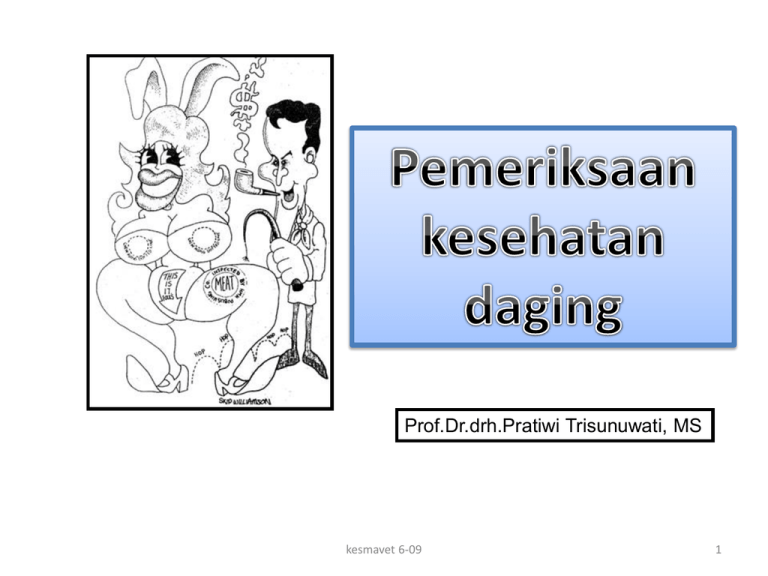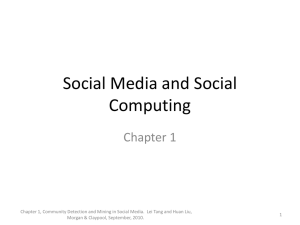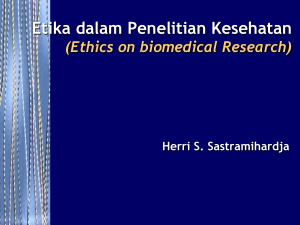Pemotongan hewan yang dagingnya diedarkan harus
advertisement

Prof.Dr.drh.Pratiwi Trisunuwati, MS kesmavet 6-09 1 Pemotongan hewan yang dagingnya diedarkan harus : a. Dilakukan di rumah potong hewan dan; b. Mengikuti cara penyembelihan yang memenuhi kaidah kesehatan masyarakat veteriner dan kesejahteraan hewan kesmavet 6-09 2 Ketentuan lain Untuk menjamin ketenteraman batin masyarakat harus memperhatikan • Kaidah agama • Unsur kepercayaan yang dianut masyarakat kesmavet 6-09 3 SISTEM JAMINAN KEAMANAN PADA RANTAI PRODUKSI (Farm to Table Food Safety) •Animal production •Slaughter & processing plants •Post-processing transportation •Wholesale & retail stores •Food service •Consumer education kesmavet 6-09 4 Rekomendasi WHO (2004) • • • • • ASPEK GOOD HYGIENE PRACTICES AVOID CROSS CONTAMINATION PENGOLAHAN PRODUK DENGAN BENAR VACCINATION PROGRAM MASAK PRODUK SAMPAI SUHU INTERNAL 70 DERAJAT CELSIUS kesmavet 6-09 5 Pemeriksaan karkas kesmavet 6-09 6 Ruang pelayuan kesmavet 6-09 7 kesmavet 6-09 8 PENGENDALIAN DAN PEMBERANTASAN PHM TERDIRI DARI TINDAKAN DENGAN 17 LANGKAH, YAITU : 1. TINDAK PENGENDALIAN PENYAKIT MELALUI PENGAWASAN LALU LINTAS TERNAK DAN PENGEBALAN TERNAK YANG TERDIRI DARI 4 LANGKAH, YAITU : 1). PENOLAKAN/KARANTINA 2). PENCEGAHAN/VAKSINASI 3). PENYIDIKAN 4). PEMANTAUAN kesmavet 6-09 9 PENGENDALIAN DAN PEMBERANTASAN PHM TERDIRI DARI TINDAKAN DENGAN 17 LANGKAH, YAITU : TINDAK PEMBERANTASAN PENYAKIT DI DAERAH TERTULAR DENGAN 9 LANGKAH, YAITU : 1). PENUTUPAN DAERAH 6). PEMOTONGAN BERSYARAT 2). PEMBERANTASAN VEKTOR 7). VAKSINASI MASSAL 3). PENGOBATAN 8). RING VAKSINASI 4). ISOLASI/OBSERVASI 9). PENYULUHAN Di daerah terancam 5). ELIMINASI/PEMUSNAHAN kesmavet 6-09 10 Hewan diistirahatkan paling tidak 12 jam sebelum dipotong. Tempatkan hewan dilokasi yang aman dan nyaman. Berikan atap untuk melindungi dari panas dan hujan agar kondisinya benar-benar fit sebelum dipotong. Berikan pakan dan air minum secukupnya, setelah itu puasakan selama 8 - 10 jam sebelum dipotong. kesmavet 6-09 11 Hewan yang terlalu banyak makan (kenyang) akan menyulitkan pada proses pemotongan dan pembersihan jerohan. Apabila memungkinkan tubuh hewan dibersihkan (dimandikan) sebelum dipotong. Saat dipotong hewan dalam keadaan bersih sehingga kemungkinan kotoran tubuh mengotori daging diperkecil. kesmavet 6-09 12 Sebaiknya pemeriksaan dilakukan malam hari menjelang dipotong atau minimal 4 jam setelah kedatangan hewan Lakukan pemeriksaan kesehatan dengan seksama. Hanya hewan-hewan yang sehat yang layak dipotong. Konsultasikan dengan dokter hewan penanggungjawab. kesmavet 6-09 13 Head inspection. Retropharyngeal (No. 1), parotid (No. 2) and submaxillary (No. 3) lymph nodes are viewed and incised by multiple incisions and slicing. Lymph nodes (Fig. 1) Submaxillary Incise(a) Parotid Incise(a) Retropharyngeal Incise(a) kesmavet 6-09 14 Fig. 3: Lung inspection - Bronchial left (No. 1) and right (No. 2) and mediastinal (No. 3) lymph nodes are viewed and incised. kesmavet 6-09 15 Liver inspection - Incised portal (hepatic) lymph nodes (No. 1) and opened large bile duct (No. 2). Spleen (Fig. 7) kesmavet 6-09 16 kesmavet 6-09 17 Fig. 9: Viewing and incision of the mesenteric lymph nodes. In this case an incision was performed to demonstrate the mesenteric lymph nodes chain. kesmavet 6-09 18 kesmavet 6-09 19 Parasites “measles” - tapeworm cysts of various kinds have been found in game carcass such as impala, kudu, bushbuck, reedbuck, sable, wildebeest (gnu, antelope) and warthogs. The cysts vary in size from that of a pea to a golf ball and are often seen in the peritoneal cavity, loosely attached to the serosa, viscera or in the musculature. . kesnavet -7-09 20 There are no special predilection sites of the muscular cysts. Routine inspection incisions for measles in domestic animals are of no value in determining presence or degree of infestation in game animals. kesnavet -7-09 21 Serosal affection can be successfully trimmed before release but muscular parasites make the carcass aesthetically unacceptable. In the latter carcass can be boiled or used for manufacturing purposes. These cysts do not seem to affect humans. kesnavet -7-09 22 Sarcocysts – these are frequently seen in the skeletal muscle of impala (mostly microscopic however); the carcass may have to be condemned if severely affected. Stilesia – this tapeworm may be found in the liver of small antelope and seem to be widespread in Africa. Trimming is required. kesnavet -7-09 23 Cooperoides hepatica – this is a small brown filarial worm which occurs coiled up in a cyst in the liver, most frequently in impala. It is often associated with stilesia. Trimming is required. kesnavet -7-09 24 Cordophillus – a filarial worm found encysted in the heart muscle of kudu. 25% of these animals are affected. This parasite is occasionally found in other muscle and may also occur in the heart muscle of domestic cattle. Affected tissue should be trimmed. kesnavet -7-09 25 Hydatid – these cysts have been seen in the lungs and livers of impala, zebra, giraffe and warthog. If slight infestation is present affected tissue should be trimmed kesnavet -7-09 26 lymph nodes in the head 1: sub-maxillary lymph nodes lie at the base of the tongue below the lower jaw bone and retropharyngeal can be found further back behind the skull... kesnavet -7-09 27 kesnavet -7-09 28 Presence or absence of organic matter Corrosive properties Type of processing area and type of surface to be disinfected Non-toxic and gentle to the skin Inexpensive kesmavet 6-09 29 Must not affect the odour or flavour of the food processed on the equipment disinfected Must be easily rinsed away and leave no toxic residues Easy to dispense and to handle Must be safe in use and must not affect the operators who use it. kesmavet 6-09 30 Chemical disinfection methods The most essential for an effective chemical disinfection programme is a clean surface. Consequently, to achieve microbial control the cleaning and disinfection programme must be thorough, compatible and totally effective. Note: A disinfectant will not cover up faulty cleaning practices The choice of chemical disinfectants is determined by the Disinfectants kesmavet 6-09 31 Disinfectants Manufacturers offer a large number of disinfectants, each claimed to be the best on the market. Nevertheless the only ones suitable for the food industry contain chemicals of one of the following groups: Chlorine and chlorine-releasing compounds Quarternary ammonium compounds Amphoteric (ampholytic) compounds Phenolic compounds Peracetic acid kesmavet 6-09 32 Emergency disinfection For emergency disinfection, i.e. when disinfection is required during processing because of animal disease (anthrax, foot and mouth disease etc.) the following disinfectants are recommended: kesmavet 6-09 33 sodium hydroxide (caustic soda or lye) in a hot solution of approximately 2% for foot and mouth disease and 5% for anthrax. (Avoid any splashes in eyes or on skin (caustic). If an accident happens wash clean water). sodium hypochlorite solution: 0.5% available chlorine hot water (90°C or more) or steam Chloride of lime for lairages, stables and transport vehicles: approximately 5% solution. kesmavet 6-09 34



